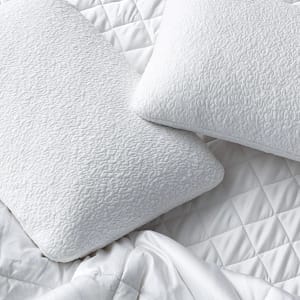The level of moisture in the air, also known as humidity, plays a significant role in your sleep quality. Whether it’s too high or too low, humidity can affect your sleep in different ways.

Effects of Humidity On Sleep
Disturbed Sleep Cycle:
High humidity can disrupt your sleep stages, including the light sleep stages, deep slow-wave stage, and the REM stage. It may increase alertness and reduce the time spent in crucial deep and dreaming sleep stages, which are vital for recovery and memory consolidation.
Allergens and Reactivity:
Humid environments are breeding grounds for allergens like mold and dust mites. These allergens can trigger reactions and interfere with your sleep. For those who are sensitive, excessive humidity can lead to uncomfortable sleep experiences.
Respiratory Issues:
High humidity can indirectly impact your sleep by worsening conditions like asthma, leading to respiratory infections, and causing breathing difficulties. These problems can disrupt your sleep patterns and make it harder to get a restful night’s sleep.
Effects of Low Humidity:
On the other hand, extremely low humidity levels can also be problematic. It can result in dry skin, itchy eyes, a sore throat, and potentially increase the risk of respiratory infections.
To achieve a comfortable night’s sleep, it’s crucial to maintain an optimal level of humidity in your home. Find that sweet spot that promotes restfulness and creates the perfect sleep environment.
Ideal Indoor Humidity for a Good Night’s Sleep
When it comes to creating the perfect sleep environment, humidity plays a crucial role. But what exactly is relative humidity? In simple terms, it’s the amount of moisture in the air compared to the maximum amount it can hold at a specific temperature. So, warmer air can handle more moisture, making those hot climates feel stickier, while cooler air tends to have higher relative humidity.
Now let’s dive into the ongoing debate about the best indoor relative humidity for optimal sleep. According to the Environmental Protection Agency (EPA), the ideal range falls between 30% and 50% – never exceeding 60%. However, other studies suggest a slightly broader range of 40% to 60%. In reality, many people consider 60% as the upper limit to avoid discomfort and excess moisture issues.
But what can you do if maintaining the perfect humidity level is a challenge? That’s where a handy device called a humidistat comes in. This wall-mounted tool, recommended by the National Institutes of Health (NIH), connects to your HVAC system. Through setting your desired humidity percentage, the humidistat will automatically activate your HVAC system to reduce humidity when it goes above the specified threshold.
Now, let’s talk about the temperature. Achieving the right bedroom temperature is equally important for a sound sleep. While it may seem cool, experts often recommend a bedroom temperature around 65 degrees Fahrenheit (18.3 degrees Celsius). This aligns with the natural drop in our body temperature during sleep, preventing overheating. If 65 degrees feels too chilly, a general range of 60 to 67 degrees Fahrenheit (15.6 to 19.4 degrees Celsius) is considered suitable for quality sleep.
By maintaining optimal humidity and temperature levels, you can create the perfect sleep environment for a restful night’s sleep.
Sleeping Well in Humid Conditions: Expert Tips for Optimal Rest
Creating an ideal sleep environment in humid conditions extends beyond basic temperature and humidity control. Here, we share additional suggestions to help you achieve peaceful slumber even in hot and muggy climates:
Adjusting AC Unit Settings
Instead of cranking the air conditioner to high, opt for a moderate airflow. Research indicates that a gentle to moderate cool breeze promotes better and longer sleep. Strong drafts, on the other hand, can disrupt your sleep and increase your heart rate due to their intensity and colder temperature.
Harnessing the Power of Dehumidifiers
When humidity levels rise, dehumidifiers become your best friends. These devices effectively reduce indoor moisture by extracting it from the air. They come in various sizes, from portable options to whole-house models that can be integrated into your HVAC system. Remember to regularly clean the filter to maximize efficiency. Some models may generate noise and slightly increase your energy costs, so keep that in mind.
Embrace Moisture-Wicking Bedding
Combat excessive sweating with sheets and pillowcases made from moisture-wicking materials like cotton or bamboo-derived rayon. These natural fibers allow for enhanced breathability, ensuring a more comfortable and dry night’s sleep. Here’s a recommendation that we absolutely adore!
Consider Alternative Mattress Options
While foam mattresses offer benefits such as pressure relief and motion isolation, they may retain more heat in humid conditions. Explore mattresses with latex and ventilated layers, moisture-wicking covers, or those with innerspring or hybrid designs featuring open coil systems. These options provide better airflow, resulting in a cooler and more comfortable sleeping experience.
By implementing these expert strategies, you can significantly enhance both the quality and comfort of your sleep in hot and humid climates. Get ready for nights filled with rejuvenating rest!
Looking for more recommendations on how to find the best temperature and humidity for sleep? Looking to find the right mattress or sheets that help regulate humidity during sleep? Chat with WonderWise on WhatsApp and ASK AWAY!!!!
